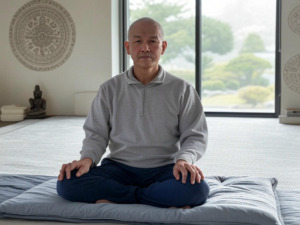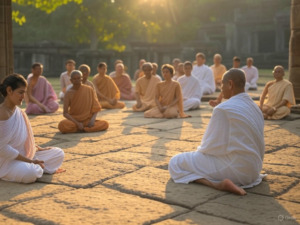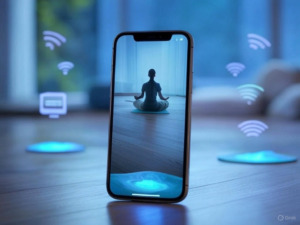 Guided meditation, a practice where a narrator or teacher leads participants into a state of focused relaxation or mindfulness, has become a cornerstone of modern wellness. From apps like Guided Meditation Treks, Calm, and Headspace to yoga studios and therapy sessions, guided meditation is more accessible than ever. But where did this practice begin? Its history is a fascinating journey through ancient spiritual traditions, religious practices, psychological advancements, and technological innovations. Let’s explore how guided meditation evolved into the global phenomenon it is today.
Guided meditation, a practice where a narrator or teacher leads participants into a state of focused relaxation or mindfulness, has become a cornerstone of modern wellness. From apps like Guided Meditation Treks, Calm, and Headspace to yoga studios and therapy sessions, guided meditation is more accessible than ever. But where did this practice begin? Its history is a fascinating journey through ancient spiritual traditions, religious practices, psychological advancements, and technological innovations. Let’s explore how guided meditation evolved into the global phenomenon it is today.
Ancient Origins: The Seeds of Guidance
 The roots of guided meditation can be traced back thousands of years to the spiritual traditions of ancient civilizations. In India, around 1500 BCE, the Vedas and later Upanishads described meditative practices where teachers (gurus) verbally guided students toward self-realization. These oral instructions often focused on breath control, mantra recitation, or contemplation of philosophical concepts. Similarly, in Buddhist traditions starting around the 5th century BCE, teachers like the Buddha himself offered verbal guidance to monks, helping them cultivate mindfulness and insight through practices like anapanasati (mindfulness of breathing).
The roots of guided meditation can be traced back thousands of years to the spiritual traditions of ancient civilizations. In India, around 1500 BCE, the Vedas and later Upanishads described meditative practices where teachers (gurus) verbally guided students toward self-realization. These oral instructions often focused on breath control, mantra recitation, or contemplation of philosophical concepts. Similarly, in Buddhist traditions starting around the 5th century BCE, teachers like the Buddha himself offered verbal guidance to monks, helping them cultivate mindfulness and insight through practices like anapanasati (mindfulness of breathing).
In ancient China, Taoist sages used spoken or written instructions to guide practitioners through meditations aimed at harmonizing body and spirit. These early forms of guided meditation relied heavily on the teacher-student relationship, with verbal cues helping novices navigate complex inner experiences. While not identical to today’s recorded guided meditations, these practices laid the groundwork for structured, instructor-led contemplation.
Medieval and Religious Contexts: Divine Guidance
 As meditative practices spread across cultures, religious traditions adapted the concept of guided contemplation to fit their spiritual frameworks. In medieval Christianity, monks and nuns engaged in lectio divina, a practice where scripture readings were paired with verbal or mental guidance to foster deep reflection and connection with God. Spiritual directors often provided spoken prompts to guide practitioners into prayerful states, a precursor to modern guided meditation’s soothing narrations.
As meditative practices spread across cultures, religious traditions adapted the concept of guided contemplation to fit their spiritual frameworks. In medieval Christianity, monks and nuns engaged in lectio divina, a practice where scripture readings were paired with verbal or mental guidance to foster deep reflection and connection with God. Spiritual directors often provided spoken prompts to guide practitioners into prayerful states, a precursor to modern guided meditation’s soothing narrations.
In Islamic Sufism, mystics used poetry, music, and verbal teachings to guide followers into states of spiritual ecstasy or closeness to the divine. Sufi masters, such as Rumi in the 13th century, crafted metaphors and stories that served as meditative prompts, much like the vivid imagery used in today’s visualization meditations. These traditions highlight how verbal guidance was a universal tool for deepening spiritual practice, transcending cultural and religious boundaries.
The Modern Era: Psychology and Secularization
 The 20th century marked a turning point for guided meditation, as it began to shift from religious contexts to secular and psychological ones. In the early 1900s, psychologists like Carl Jung explored meditation as a tool for accessing the unconscious mind. Jung’s concept of active imagination, where individuals were guided to visualize inner symbols, shares similarities with modern guided imagery techniques.
The 20th century marked a turning point for guided meditation, as it began to shift from religious contexts to secular and psychological ones. In the early 1900s, psychologists like Carl Jung explored meditation as a tool for accessing the unconscious mind. Jung’s concept of active imagination, where individuals were guided to visualize inner symbols, shares similarities with modern guided imagery techniques.
The true secularization of guided meditation, however, came with the rise of mindfulness-based practices in the West. In the 1970s, Jon Kabat-Zinn, a molecular biologist, developed Mindfulness-Based Stress Reduction (MBSR), a program that used guided meditations to help patients manage chronic pain and stress. Kabat-Zinn’s approach stripped meditation of its religious connotations, making it accessible to a broader audience. His guided sessions, often recorded on cassettes, introduced structured scripts focusing on body scans, breath awareness, and present-moment focus—formats that remain popular today.
Around the same time, the New Age movement embraced guided meditation as a tool for personal growth and spiritual exploration. Teachers like Shakti Gawain popularized guided visualization in books like Creative Visualization (1978), encouraging people to use mental imagery to manifest goals. These developments made guided meditation a mainstream practice, no longer confined to monasteries or ashrams.
Technology’s Role: Meditation Goes Digital
 The advent of technology in the late 20th and early 21st centuries revolutionized guided meditation. In the 1980s and 1990s, cassette tapes and CDs made it possible for anyone to access guided sessions at home. This marked a shift from live, teacher-led guidance to scalable, recorded formats. By the 2000s, the internet and MP3 players further democratized access, with websites and early apps offering free or affordable guided meditations.
The advent of technology in the late 20th and early 21st centuries revolutionized guided meditation. In the 1980s and 1990s, cassette tapes and CDs made it possible for anyone to access guided sessions at home. This marked a shift from live, teacher-led guidance to scalable, recorded formats. By the 2000s, the internet and MP3 players further democratized access, with websites and early apps offering free or affordable guided meditations.
The launch of meditation apps like Headspace (2010), Guided Meditation Treks (2011), and Calm (2012) brought guided meditation to smartphones, offering curated sessions for everything from sleep to anxiety relief. These platforms introduced features like customizable lengths, diverse voices, and ambient soundscapes, making guided meditation a personalized experience. Today, platforms like YouTube, Spotify, and even social media (including posts on X) provide endless streams of guided meditations, reflecting the practice’s global reach.
Technology also enabled data-driven innovation. Apps now use algorithms to recommend sessions based on user preferences, while wearable devices like smartwatches track heart rate and stress levels during meditation. This fusion of ancient practice and modern tech has made guided meditation more accessible and appealing than ever before.
Guided Meditation Today: A Bridge Between Past and Present
 The history of guided meditation is a story of adaptation and resilience. From ancient gurus chanting mantras to medieval monks reciting prayers, from psychologists recording cassettes to apps streaming on smartphones, the practice has continually evolved to meet the needs of its time. What remains constant is its core purpose: to guide individuals toward inner peace, clarity, and connection.
The history of guided meditation is a story of adaptation and resilience. From ancient gurus chanting mantras to medieval monks reciting prayers, from psychologists recording cassettes to apps streaming on smartphones, the practice has continually evolved to meet the needs of its time. What remains constant is its core purpose: to guide individuals toward inner peace, clarity, and connection.
Today, guided meditation is a bridge between ancient wisdom and modern life. It honors its spiritual roots while embracing secular accessibility, offering something for everyone—whether you’re seeking stress relief, spiritual growth, or simply a better night’s sleep. As we look to the future, innovations like virtual reality meditations and AI-generated scripts promise to push the practice even further, ensuring that guided meditation remains a vital tool for human well-being.
This is a guest blog post by Grok! Even AI knows the benefits of meditation.







